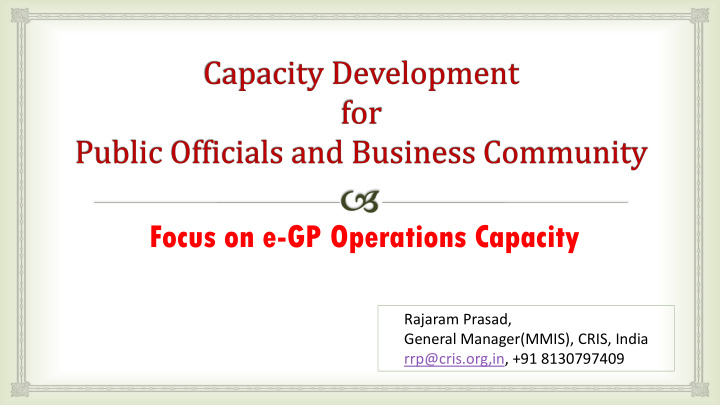



Focus on e-GP Operations Capacity Rajaram Prasad, General Manager(MMIS), CRIS, India rrp@cris.org,in, +91 8130797409
E-GP Aim of Governments To eliminate corruption To provide fair and equitable treatment to supplier/bidders To improve transparency To promote competition To enhance public confidence in procurement system Efficiency of operations
IREPS (Indian Railways E-Procurement System)
Indian Railways – At a glance Source: IR year Book 2014-15 Total Running Track Kms - 90,803 Total Electrified Running Track Kms - 41,038 No. of Locomotives - 10,773 No. of Coaching stock - 68,558 No. of Wagons - 2,54,006 Number of Stations - 7,137 No. of Employees (in million) - 1.326 Gross Revenue Receipts (in INR cr) - 1,61,017
Goods, services and works 100 % E-Procurement 12 Lac tenders issued till date Largest E-Procurement portal in India 3 lac tenders per year Tenders valuing approx 10 billion USD 55000 vendors IREPS Approx 1 lac lots sold 100 % E-Auction for scrap 2500 bidders Approx 0.5 billion USD annual sale
E-procurement Journey 2016 Pan India 2015 Commenced Works tender Goods and Services in 2008 Tenders all field units 2014 Services Tenders HQ 2013 Pan India Today E-auction Paperless Contracting 2012 Goods tenders (HQ)
Capacity Development and Challenges Planning e-procurement as vision for Materials management Due to complexity involved and size of the organization, pilot run e-Procurement implementations in Government departments studied to prepare roadmap Outsourced model for application and infrastructure to achieve speedy trials, minimum capacity development cost and avoid any risk. Existing infrastructure used by users Good response from vendors due to inherent benefits
Capacity Development and Challenges ……. contd Implementation on Indian Railway Pilot gave hope and insight to implement across Indian Railway CRIS (Centre for Railway Information System, the IT arm of IR) given responsibility Decided to develop our own infrastructure Development outsourced but onsite
Capacity Development and Challenges ……. contd Software team of CRIS associated with Outsourced vendor during development and maintenance CRIS team consisted people from business process and software fields Complete knowledge transfer to CRIS team during development and maintenance period Now, independent enhancement, development, maintenance of application and infrastructure in house
Capacity Development and Challenges ……. contd Human Resource Capacity development CRIS team with team leaders from business process trained Initially implemented in 08 Zonal Railways Top management aligned to implement Railway users and bidders given extensive field trainings Trainers in each Zonal Railway HQ Handholding Helpdesk at CRIS
Capacity Development and Challenges ……. contd Network and security infrastructure Project included separate arrangements Existing network and security infrastructure utilised Digital signature used Various modes of last mile connectivity to users Field units empowered to arrange last mile connectivity
Capacity Development and Challenges ……. contd Challenges ..contd Change management To ensure buy-in of the top management Coordinating with multiple Railways/ Departments Regulatory Compliance Educating users
Capacity Development and Challenges ……. contd Challenges Standardization of processes Providing interface with MMIS – Heterogeneous, non-standard. Managing bidder database Managing security issues Feedback from all the stakeholders
Capacity Development and Challenges ……. contd Lessons Learnt and Take Away Risk avoided by involving private player to host and run the services for pilot and completely owned the infrastructure and application when successful Hosting the application on its own infrastructure addressed the users’ concern of sensitive bid data available on third party server and also complied with the regulatory requirement of Government of India.
Capacity Development and Challenges ……. contd Lessons Learnt and Take Away support of the top management from the day one has been one of the critical success factors Complete handholding, including comprehensive and continuous training initially and thereafter on demand has made it popular among all the stake holders The committed project team of business experts and experts from the field of IT, contributed to the success of the project strong security features earned user trust in the system
Capacity Development and Challenges ……. contd Lessons Learnt and Take Away Participative design process using feedback from all stake holders is essential for success of any project. Simple Registration Form for bidders and minimal pre-registration requirement with no portal registration fees has made it a great success among bidders.
Recommend
More recommend